Marker Text
Note: The term “Indian” is used instead of “Native American” or “American Indian” as it was the common usage of the time this marker was cast.
Prehistoric Indians were the earliest inhabitants of this area. By 1760, the Oto and part of the Missouri Tribe occupied an earth lodge village near here on the west bank of the Platte River, a short distance above the mouth of the Elkhorn. Spanish and French explorers made contact with the Oto during the late 18th century.
In July, 1804, men from the Lewis and Clark expedition traveled to the Oto village only to find the tribe away on their annual buffalo hunt. When the Indians returned, the explorers held a council with them at a site on the Missouri River which became known as “the council bluffs.” During the 1830’s, Baptist missionaries Moses and Eliza Merrill worked among the Oto and Missouri. In 1854, the tribes ceded their lands along the Platte and Elkhorn and moved to a reservation on the Blue River near the Nebraska-Kansas border. The present-day community of Yutan is named after Itan, chief of the Oto from about 1830 until his death in 1837. Two Rivers State Recreation Area, at the confluence of two historic waterways, was opened in 1960 by the State Game and Parks Commission.
Location
27702 F St, Waterloo, Douglas County, Nebraska. View this marker’s location 41.224231, -96.35793
Further Information
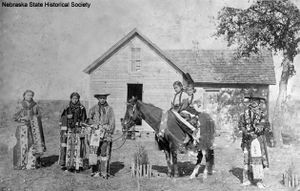 Originally two distinct peoples, the Otoe (also spelled Oto) and Missouria tribes fused in the late 1700s into one group, though the Missouria maintained some distinctive features within the combined tribe.
Originally two distinct peoples, the Otoe (also spelled Oto) and Missouria tribes fused in the late 1700s into one group, though the Missouria maintained some distinctive features within the combined tribe.
Origins The Otoe people trace their origins to the Great Lakes region. In the seventeenth and eighteenth centuries, they migrated across Iowa and Minnesota into Nebraska after being forced from their home by the Dakota Sioux. The Dakota were migrating west at this time to avoid the increasing numbers of white settlers in the east and to take advantage of the plentiful game in the plains. By 1714, they made their home near the Platte River. In 1798, the Missouria, a closely related tribe, joined them in Nebraska after they were forced from their homes by the Sauk (Sac) and Fox tribes. While the Missouria remained a distinct band within the tribe, the Otoe and Missouria largely functioned as one group.
Tribal Life The Otoe-Missourias lived in earth lodge villages for only part of the year. Villages were centers of intensive agriculture, which provided the tribe with much of its food base. The rest of its food supply came from biannual buffalo hunts. Other sources of food collection added to these main sources of subsistence.
An Otoe-Missouria village near Yutan has yielded copious information about Otoe-Missouria village life. The village was founded in 1775 and was occupied until 1837. It was one of the first villages seen by fur traders traveling up the Platte. The houses found at Yutan were circular and covered in grass and dirt. A small circle was left at the top of the house to allow smoke to escape. Pits were made outside of the houses to store extra food and waste. The tribe was very in tune with the cycles of their physical surroundings and based their calendar accordingly. Religious ceremonies accompanied the yearly cycle of food production. Little is known about Otoe-Missouria religion, since most traditions disappeared before they could be recorded. When an anthropologist attempted to record the tribe’s traditions in 1935, he was told he arrived “fifty years too late.” The tribe consisted of ten clans, each claiming different traditions, privileges and supernatural origin. They were bound together by the participation in village events and leadership.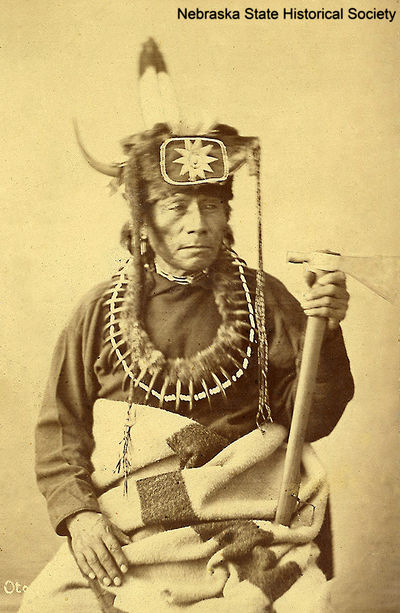
Fights between Plains Indian tribes were a normal occurrence, but it was not exactly warfare. Instead, groups of men from one tribe would raid a village from another tribe mainly for plunder. Raids formed a critical component of Indian society. Success in raids could promote a man in the hierarchical structure of society, bringing them wealth and status. In some cases, raids could also be ways of exacting vengeance on other tribes. The Otoe-Missouria generally fought against any other tribe, though they were sometimes at peace with the Pawnee and Kansa.
Contact Contact with white settlers drastically changed Otoe-Missouria life. The most destructive change came in the form of smallpox, which European-Americans had unwittingly brought with them and which decimated native populations. As much as 70% of unimmunized victims could die in a given outbreak. Several epidemics of smallpox swept through the plains, including big ones in 1800-1 and 1837-8. The huge drops in population following these epidemics affected Otoe-Missouria traditions and threatened their subsistence base by depleting the work supply.
Not all the changes brought by white contact were as destructive as smallpox, though few changes were positive. Horses, for example, made hunting buffalo much easier. European tools and utensils made food preparation less tiresome. At the same time, the reliance on the white man’s wares reduced traditional labor practices and increased dependence on foreign powers.
The Villasur Expedition One of the first appearances of the Otoe in the historical record (and, indeed, one of the first appearances of what would become Nebraska) was a battle between Spanish forces and the combined forces of the Otoe and Pawnee tribes. On August 14, 1720, Sir Pedro de Villasur of Spain, the leader of a military expedition into the Great Plains, was attacked by the Otoe and Pawnee. His force was annihilated. The battle ended Spain’s hopes of extending its power into the region.
Meeting with Lewis and Clark The Otoes were the first Indian tribe to meet with the explorers Lewis and Clark. The explorers met with members of the tribe at a site called Council Bluffs (located near present-day Fort Calhoun, Nebraska, not near the city in Iowa called Council Bluffs) on August 3, 1804. The chiefs of the Otoes could not make it, so Lewis and Clark addressed the members who had come and sent a written copy of his speech, along with gifts, to the rest of the Otoes. A copy of this speech has been preserved. They stressed that the United States had sovereignty over these lands now but that the “Great Father” of the “Seventeen Nations of America” had the Indians’ best interests in mind. If the Indians incurred the wrath of the Great Father, however, they would be consumed “as the fire consumes the grass of the plains.” On August 19, Lewis and Clark held another council with the Otoes farther up the Missouri River, this time with the chiefs present. The meeting did not bear much fruit. The Otoes were wary of American influence in the fur trade and its relation to intertribal politics. They were also displeased with the gifts they had received from the explorers. The disappointing outcome of the meeting set a tone for future meetings between the government and native peoples. The Omaha, Pawnee and Ponca tribes were on their buffalo hunts during this time, so they did not meet Lewis and Clark.
The Fur Trade The Otoe-Missouria played an important role in the fur trade as the trading post at Bellevue resided in their territory. At first, they participated in the fur trade because they profited from the exchange of goods. As the economy of the fur trade changed over time, they were reduced to a more dependent state in relation to the fur traders. The trade forced the Indians to abandon much of their traditional work in favor of work beneficial to the trade, and power politics disrupted traditional tribal organization. Involvement in the fur trade was the first major step in the destruction of the Plains Indians.
Fur traders exchanged more than goods. Fur trading posts like Bellevue became important places where Native American and European American cultures merged. Many employees at the fur trading posts took Indian brides, resulting in a high mixed-blood population. Two Omaha chiefs, Logan Fontenelle and Joseph La Flesche, were products of this mixing.
Even though its sale to Indians was restricted by the government, alcohol became an important trade good between the Otoe and the fur traders. The massive influx of alcohol into the region resulted in many social problems for the Otoe-Missouria, however. Two Otoe chiefs, while intoxicated, got into a brawl leaving one dead and one with his nose bitten off.
The fur trade also helped spread disease. In 1849, a steamboat owned by the American Fur Company traveled up the Missouri to trade even though the crew was infected with cholera; the company did not want to lose the season’s trade. The Omaha and Otoe-Missouria at first avoided the worst of the disease because many of them were on buffalo hunts at the time, but it traveled through westward emigrants to the west, where it killed a quarter of the Pawnee.
Efforts at Assimilation In the 1830s, Christian missionaries worked among the Indian tribes. Christianization and Americanization were tightly linked; missionaries worked not only to convert the Indians to Christianity but also to American ways, like individual farms. The Otoe-Missouria were the first Nebraska tribe to have a missionary. Moses Merrill and his wife arrived at Bellevue in 1833. In 1835 they created a new mission near the confluence of the Platte and Missouri rivers. The mission was vacant for a time after Merrill’s death in 1840, but in 1845 Edmund McKinney and his wife moved to the mission and stayed there until the 1850s. The missionaries, while they had little respect for Indian culture, sought to protect the Indians from harm. During times of famine and sickness, the missionaries’ supplies of food and medicine helped the tribes stay alive. They also saw their Americanization work as humanitarian; if the Indians didn’t adopt white ways, the settlers and the military who were soon to move into the region would surely cause worse damage than the loss of cultural heritage. Thus, the missionaries were often the only whites the Indians trusted.
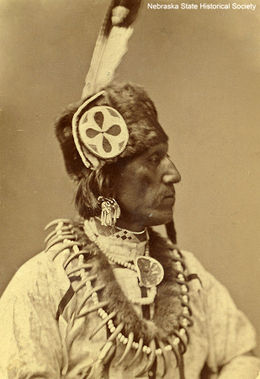 Land Cessions The policy of Americanization included the gradual acquisition of Native land by the government. The first cession of land by Native Americans in Nebraska was at the Treaty of Prairie du Chien in 1830. In this treaty, the Otoe-Missouria gave up all their claims of land east of the Missouri. While the treaty said the Otoe-Missouria could still hunt on the land, other Indian tribes later occupied the land and the government quietly extinguished the Otoe-Missouira claim. As part of the same treaty, the southeastern tip of Nebraska was set aside as the Nemaha Half-Breed Reservation, a place where half-breed Omaha, Otoe-Missouria and Iowa could live. This reservation, the first individual allotments given to Native Americans, was paid for with money coming out of the annuities of the other tribes. Within a decade, almost every allotment was sold to whites. In 1833, the Otoe-Missouria ceded about 1 million acres of land between the Great and Little Nemaha rivers south of what is now Lincoln for a total of $40,000 in annuities and various services and improvements. This payment amounted to 4.1 cents per acre.
Land Cessions The policy of Americanization included the gradual acquisition of Native land by the government. The first cession of land by Native Americans in Nebraska was at the Treaty of Prairie du Chien in 1830. In this treaty, the Otoe-Missouria gave up all their claims of land east of the Missouri. While the treaty said the Otoe-Missouria could still hunt on the land, other Indian tribes later occupied the land and the government quietly extinguished the Otoe-Missouira claim. As part of the same treaty, the southeastern tip of Nebraska was set aside as the Nemaha Half-Breed Reservation, a place where half-breed Omaha, Otoe-Missouria and Iowa could live. This reservation, the first individual allotments given to Native Americans, was paid for with money coming out of the annuities of the other tribes. Within a decade, almost every allotment was sold to whites. In 1833, the Otoe-Missouria ceded about 1 million acres of land between the Great and Little Nemaha rivers south of what is now Lincoln for a total of $40,000 in annuities and various services and improvements. This payment amounted to 4.1 cents per acre.
Difficulties in the 1800s The Otoe-Missouria population experienced a great decline after 1820. Food started to become scarce in the 1820s onward, and smallpox hit the tribe in 1831. Fortunately, the tribe experienced fewer losses in the smallpox epidemic of 1839 because over half the tribe was inoculated. Still, the previous outbreaks of disease greatly shifted Otoe-Missouria demographics; children made up almost half the tribe. During the early 1800s, the government tried to blend the Missouria and Otoe, as it was more cost-efficient to deal with one tribe instead of two. Ironically, the pressures the tribes experienced as a result of government policy exacerbated the division between the tribes. In 1839, the Missouria formed their own village apart from the main Otoe village.
The Otoe themselves were also divided. In 1837, Ietan, the principle chief of the Otoe and the namesake of Yutan, was killed in a dispute with two of his tribesmen who had run off with two of his five wives. The chief’s rivals were also killed in the battle. The tribe was split between supporters of Ietan and supporters of the two other men. No strong leaders were able to effectively lead the tribe in the difficult years following Ietan’s death. The tribe’s lack of leadership led to lawlessness and hostility against whites, giving the tribe a reputation as “the most rascally Indians in the West.” For example, two Otoe men fired on a boat in the Missouri, wounding one man. They were brought to Fort Leavenworth, where one escaped and another was killed attempting to escape. In February of 1841, a group of drunken Otoe men burned their village to the ground. Instead of rebuilding the village where it was, the Otoe dispersed into four separate villages. This was indicative of the factionalism within the tribe as well as the poverty it faced. By spreading out, the tribe was better able to manage resources. The remainder of the 1840s was a dark time for the tribe. Many tribesmen traded what remained of their resources for alcohol. A series of bad harvests, floods and epidemics reduced the tribe to only half of its 1820 population. Education was the focal point of acculturation policies. Edmund McKinney had a school at Bellevue attended 47 students representing the four eastern Nebraska tribes. Both the boys and the girls at the school learned English, but only the boys were taught math and geography. The girls were instead taught to be housewives.
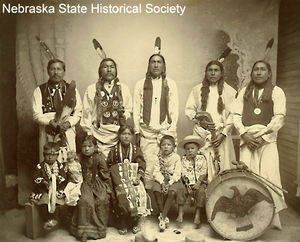 The Kansas-Nebraska Act and the Reservation Passed in 1854, the Kansas-Nebraska Act created federally administered territories in the lands west of the Missouri River, land which had previously been set aside as a “permanent Indian frontier.” The act opened these lands for white settlers, meaning the Indians had to be removed from their land. The Otoe-Missouria were the first Nebraska tribe to settle on a reservation. In 1854, the tribe signed a treaty agreeing to move to a 10-mile-by-25-mile reservation near the Big Blue River along the Nebraska-Kansas border. The tribe moved to the reservation in July of 1855. The land was generally very good, and there were few pressures from settlers. Still, life on the reservation was poor. Annuity payments were late in coming, and even when the annuity payments did arrive on time, they were woefully insufficient. Annuity payments amounted to only $18 per capita, barely enough to buy a bag of flour. The grist mill set up by the government was successful, but the government mismanaged just about everything else. Otoe-Missouria children did not want to go to school, and men did not want to farm. Regulations against alcohol were relaxed in 1847, so drinking remained a big issue. Hostilities continued within the tribe, and the Cheyenne became a major threat from outside the tribe.
The Kansas-Nebraska Act and the Reservation Passed in 1854, the Kansas-Nebraska Act created federally administered territories in the lands west of the Missouri River, land which had previously been set aside as a “permanent Indian frontier.” The act opened these lands for white settlers, meaning the Indians had to be removed from their land. The Otoe-Missouria were the first Nebraska tribe to settle on a reservation. In 1854, the tribe signed a treaty agreeing to move to a 10-mile-by-25-mile reservation near the Big Blue River along the Nebraska-Kansas border. The tribe moved to the reservation in July of 1855. The land was generally very good, and there were few pressures from settlers. Still, life on the reservation was poor. Annuity payments were late in coming, and even when the annuity payments did arrive on time, they were woefully insufficient. Annuity payments amounted to only $18 per capita, barely enough to buy a bag of flour. The grist mill set up by the government was successful, but the government mismanaged just about everything else. Otoe-Missouria children did not want to go to school, and men did not want to farm. Regulations against alcohol were relaxed in 1847, so drinking remained a big issue. Hostilities continued within the tribe, and the Cheyenne became a major threat from outside the tribe.
The Dark 1860s Life on the reservation got even worse during the 1860s. The decade got off to a bad start with a drought in 1860. While nearby white settlers could simply move to wetter areas if needed, the Otoe-Missouria were trapped on their reservation. The supposed agricultural aid provided by the government barely helped, as only 3 acres of farmland were added between 1862 and 1869. Buffalo hunts also became less viable during this time. The Otoe-Missouria’s traditional hunting grounds were settled by whites, so they were forced to hunt elsewhere. Their new hunting grounds were frequently plagued by hostile Cheyenne and Sioux hunters.
Total disaster seemed to arrive on the reservation between 1867 and 1869. In 1867, floods destroyed crops, and tribe members were forced to scour the countryside for cattle and hog meat. That year, 21 Otoe-Missouria died from eating tainted meat. The harvest of 1868 was completely destroyed by drought and grasshoppers. By 1869, the tribe faced starvation but was saved by emergency provisions- though those provisions cost them an advance on their annuity. The population of the tribe dropped below 500 for most of the decade, reaching an all-time low of 434 in 1870.
The tribe’s problems were exacerbated by corrupt and inept government leadership. In 1861, William Dennison, the tribe’s agent, took the tribe’s $13,554 annuity payment for himself and ran off to Nebraska City, claiming he was ill. A band of Otoe men traveled to Nebraska City demanding payment. The townspeople were worried by rumors that the Otoe sought to reclaim their land. Ar-ka-ke-ta, the principle Otoe chief, and several other Otoe-Missouria leaders held a conference with Dennison. When Dennison refused to hand over the money, the chiefs tied him to a chair. While he was eventually released, the money was not returned. Dennison disappeared and would not be heard from again until 1863, when he got a job with the Confederate government in Richmond. The government gave the tribe a $1,000 advance on their annuity, but the rest of the money Dennison embezzled was not returned until several years later. A new agent, John Barker, arrived later that year to find that the government employees on the reservation had also not been paid in a year, and much of the reservation’s farming equipment had found its way into the hands of white farmers. The tribe questioned Barker’s leadership as well, as the value of the tribe’s farming enterprise only increased by $500 when $2800 had been spent on agricultural improvements.
Quaker Reforms An honest agent, Albert Lamborn Green, finally arrived in 1869, when President Grant allied with the Quakers to initiate the age of Quaker reforms on the reservation. Green was dedicated to helping the Otoe-Missouria succeed on their reservation and was not corrupt like his predecessors. The Quakers, however, were even more dedicated to dismantling traditional Native American culture. Historian Daniel W. Overton described the Quaker program in four parts: “(1) [P]rotect Indian interests by locating reservations outside the main routs of white expansion; (2) provide all necessary education, tools, and agricultural implements; (3) break down tribal ties, political and social, seen as barring the path to ‘civilization’; and (4) allot lands in severalty to individual Indian households as a means of putting them on a comparable economic and cultural footing with their habitually covetous white neighbors.”
Green made education a primary concern. Unlike earlier attempts at Otoe-Missouria education, the school was successful as the tribe realized education was necessary for integration into the local economy. By 1875, a boarding school was established on the reservation. This was seen as preferable because it insulated the students from traditional Indian culture. Green was also somewhat successful at increasing the agricultural output of the tribe. The amount of farmland increased from 210 acres in his first year to 540 acres in 1871, after two years of his leadership. The following two years, however, the number dropped to 200 acres as plows disappeared mysteriously and more men refused to do the “women’s work” on the farm. There was little medical care on the reservation. For most of Green’s tenure, there was no doctor to care for the sick. This proved to be problematic, as disease continued to ravage the Indian population. A newspaper reporter decided that the Indians were so sick because they lived in earth huts, and Green claimed the Native Americans did not understand the “laws of health.” No one realized that the diseases plaguing the Indians were inadvertently brought to the Americas by the white man, and that the Natives had no natural immunity to these diseases.
Life on the Reservation By 1870, most of the land surrounding the reservation had been occupied by whites. The region’s isolation from railroads and cities forced the settlers to steal timber and horses from the Otoe-Missouria. The reservation’s boundaries were not clearly marked on the ground, so it was difficult to prove when the reservation’s land had been violated. In 1867, the Otoe-Missouria chiefs signed a treaty agreeing to sell over half of their reservation for $1.25 an acre. The treaty was not immediately ratified by Congress, and when Green arrived in 1869, he advised the tribe to rescind the treaty since the land was worth much more than that.
Despite the efforts of Green and others, the Otoe-Missouria remained very traditional. They continued their buffalo hunts and lived in earth lodges. Some men still had multiple wives, and only three men, all mixed-bloods, could speak English. Green deposed Ar-ka-ke-ta as chief in 1871 because he opposed Green’s cultural changes. Eventually, a rift developed within the tribe between those dedicated to traditional ways of life and those willing to accept Americanization. The traditional faction was more willing to sell the reservation, as they believed that they could continue their old ways in Indian Territory. The accommodating faction wanted to keep the Nebraska land and was willing to accept American ways to do so.
Divisions within the tribe were exacerbated by poor harvests. Many tribal members were reluctant to plant crops, since they expected the reservation to be sold. Others refused to plant because it violated traditional ways; one man was killed after mocking another man for planting crops. When crops were planted, they were almost always destroyed by nature. Weak buffalo hunts contributed to the tribe’s poverty. They did not have a successful hunt after 1872 and gave up hunting altogether in 1875.
According to the 1854 treaty, the tribe would be paid only $9,000 a year after 1867. This small amount of funds was mostly spent on agriculture and other improvements. Each tribe member received only $3.50 a year (chiefs received $4). In 1873, the government decided that funds would only be disbursed in the forms of agricultural aid and wages for labor. In the latter sense, the Indians were being paid to do jobs with money that was already theirs. Many members of the traditional faction (called the “wild party” by the agents) refused to work and instead made money selling timber to settlers. While there were many contentious and violent encounters between whites and Indians near the reservation, there were some peaceful encounters as well. For example, the Otoe-Missouria baseball team played against a team from Hebron to compete for the league title in 1874.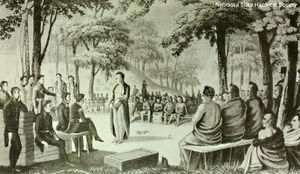
Losing the Reservation In 1872, Congress passed a law authorizing the sale of half the reservation with approval of the tribal council. Much of the tribe wanted to sell the land and move to Indian Territory. Some of the chiefs had visited Indian Territory and found it suitable land. Moreover, the Nebraska state government was eager for the Otoe-Missouria to leave so white settlers could move onto the land. Still, the government was only ready to sell part of the land. The tribe rejected this offer in 1873, expecting an all-or-nothing deal.
Despite continued resistance from the “wild party,” the tribe finally agreed to sell part of the reservation in 1876. The deal included 120,000 of the 160,000 acres of the reservation, which were to be sold at no less than $2.50 an acre. The money from the sale would be put into a treasury account and given to the tribe in annual payments with 5% interest. A council of chiefs agreed to these conditions on December 23, 1876, adding that they wanted honest men to appraise the land. Members of the “wild party” did not consent to the agreement.
Much of the land sold went into the hands of squatters, who stripped the land of its timber and left without paying. As such, the tribe never received the full amount of the sale. In the years following the sale, more and more tribe members wanted to move to Indian Territory. Finally, in 1880, a government inspector met with the tribe and recommended they move south. That year, almost 200 Otoe-Missouria (mostly consisting of the “wild party”) moved into Indian Territory. In 1881, the reservation was sold to the government, and the rest of the tribe moved to Indian Territory, where they resided on a 129,113 acre reservation between the Ponca and Pawnee reservations. The old Nebraska reservation sold for an average of $12.22 an acre, more than any other Indian land sold for during the 1800s. Despite this, the tribe again failed to collect the full worth of the sale since many purchasers later defaulted on their payments.
Indian Territory The land the Otoe-Missouria received in Indian Territory was not very fertile and had little timber. The tribe remained traditional, much to the chagrin of the Indian Office, who considered them “lazy.” The “wild party” separated themselves from the rest of the tribe. They lived near the reservations of the Iowa and the Sauk and Fox tribes but returned to the rest of the tribe in 1890, when the Iowa reservation was turned into individual allotments under the Dawes Act.
Only 340 Otoe-Missouria remained in 1894, the lowest recorded population in their history. In 1899, the tribe’s reservation was abolished and members were put on individual allotments of land according to the Dawes Act. Unlike most tribes, the Otoe-Missouria were able to keep most of the land in their reservation after the move to allotments. This changed when oil was discovered on their land in 1912; by 1920, 90% of their land was in the hands of whites.
The Otoe-Missouria in the 20th Century The Otoe-Missouria have resisted change since their removal. They kept their traditional tribal government until 1984 and continue to have an annual powwow. In the 1940s, they received payments of $1,750,000 and $1,156,035 from the Indian Claims Commission in reparation for their lands sold at low prices in 1830, 1833 and 1854. In 1990, the tribe had 1,550 members in 1990.




